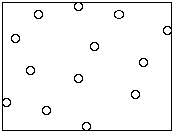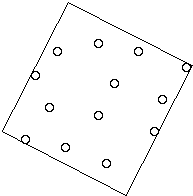 |
|||
|
|||||||||||||||||||||||||||||
|
|
|||||||||||||||||||||||||||||
|
|
Square-ness, Example #1 (solution) || Steep-ness, Example #2 (solution) Compact-ness, Example #3 (solution) || Crowded-ness, Example #4 (solution) Awkward-ness, Example #5 (solution) || Sharp-ness, Example #6 (solution)
Malcolm Swan
Jim Ridgway
Which looks the most "crowded"? Put the groups in order of "crowdedness", just by looking.
Intuitively, most people would consider the least crowded to be F, and the most crowded group to be C and, they would give the following rough order for "crowdedness": F, B, A, C. The remaining groups are quite 'odd' in that D seems to be distributed less evenly and E seems to be distributed somewhat linearly. There should therefore be some disagreement about these points. Intuitively, "crowdedness" gives the feeling of "closeness" or "confined-ness"; thus it may mean the proximity of one person to another or the denseness of a collection of people in a defined space.
The solution for group F gives a rectangle which is approximately 27 m2 in area.

This area is not a good measure for "crowdedness," because it takes no account of the number of people in the rectangle. Also, there is more than one rectangle that just touches the extreme people, giving a different area. For example:

A better solution would be one in which we
For example, we could define "crowdedness" as:
Next, having chosen a measure of compactness, the student must show its application by computing numerical compactness values for the given groups. Using the definition: area of smallest circle that will surround the group divided by the number of people within it, I obtained the following results (units are in people per square meter).
Thus the order from the least crowded to most crowded, using this definition is:
Compact-ness, Example #3 (solution) || Crowded-ness, Example #4 (solution) Awkward-ness, Example #5 (solution) || Sharp-ness, Example #6 (solution)
|
Search || Who We Are || Site Map || Meet the CL-1 Team || WebMaster || Copyright || Download
College Level One (CL-1) Home || Collaborative Learning || FLAG || Learning Through Technology || NISE